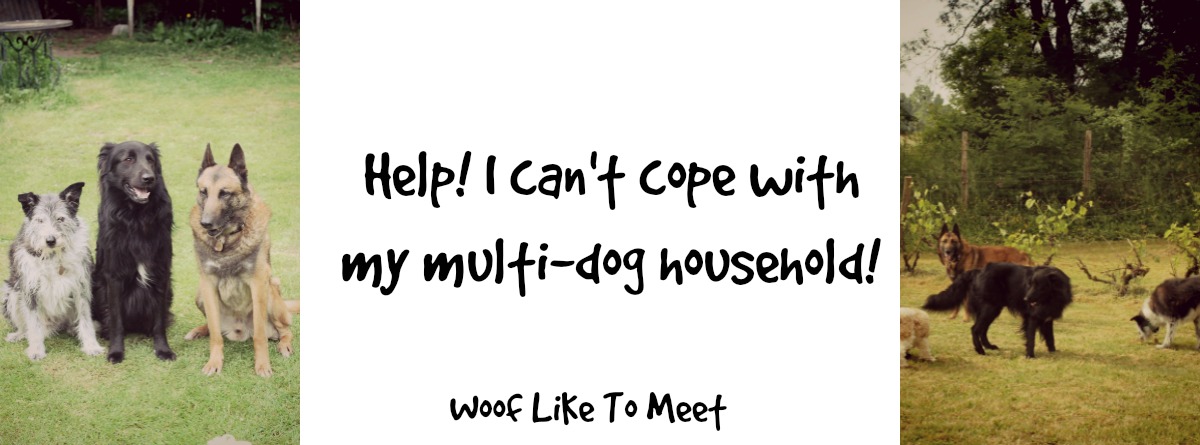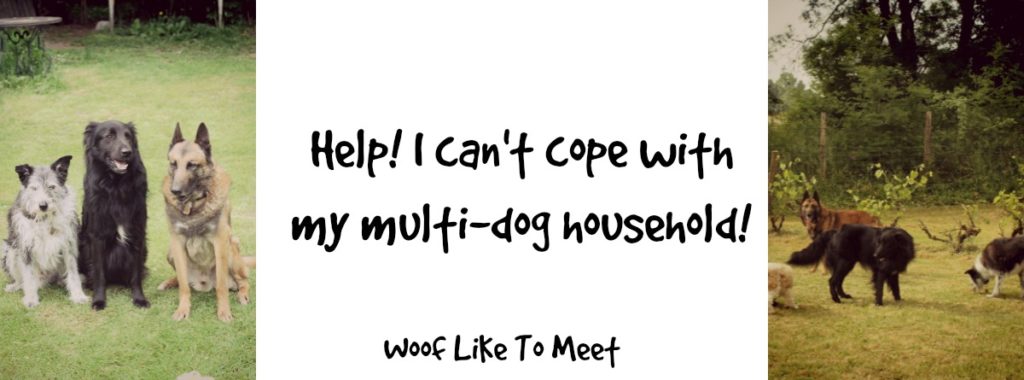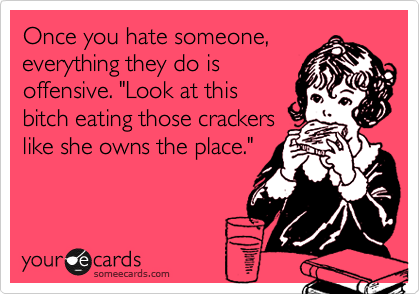One reason dogs can be surrendered to the refuge is that the dynamic in the group is hard to handle. It’s also a source of a good number of calls post-adoption trying to negotiate pack issues, as adoptants try desperately to ensure everybody rubs along okay. Often, it’s not a problem with their new dog either, or it’s a combination of issues with their new dog and a resident. You can, of course, read up on how to introduce dogs to established groups here and here which should help you a little with that.
The hardest thing for people who have adopted a rescue dog rather than buying a puppy is that you are dealing with dogs who have already established preferences for things but dogs who may have had as little training as a puppy. They come to your home with their baggage about what home means to them, and a set of rules that have been lost in transit. They come with an unknown level of training, too.
You take them from the relative routine and security of a shelter and it’s hard to understand that, often, your new home is WAY more stressful for a dog than a shelter in a range of diverse ways. Shelters don’t have couches. They don’t have five other dogs hanging around you at feeding time. There might not be a squabble over beds, resources or affection. Get a new dog into your canine family and you’ll soon find yourself with dynamics that you just don’t understand. If you’re lucky, there’ll be relatively few teething problems. For most people, though, they’ll find themselves trying to referee issues they really don’t always understand.
Take yesterday, for instance. I spent the day at an event with one of my foster dogs. He’s been here for twelve weeks. There’s been one scrap in that time, but it was all noise and posture. At various points in the day, the dogs are split up. Yesterday, I got back and there was an almighty growling session that lasted a good couple of minutes. It’s hard with your own dogs to remember that growls and grumbles are their way of sorting out their own battles. Sometimes, intervening can make the problem worse, not better. It’s worth seeking advice about how to help out persistent growls and grumbles though.
It is hard to accept as well that dogs have preferences for each other. Although Mim and Fefelle arrived as a pair, they are certainly not a bonded pair. They don’t actually seem that interested in each other. Amigo and Tobby seem to have an easy friendship and never squabble, but they never get cuddly. Tilly and Heston have a tenderness that is quite touching.
We have this vision, however, that dogs are 100% or 0%, or that they have types they prefer. They’re either social or they’re not. They get on with big dogs or they don’t. Both of those things can be true, of course. There are dogs at the shelter who we have consistently been unable to pair up with another, be they male or female, big or small. There are little dogs that we’ve been able to only pair up with giants, and there are big dogs who look at little dogs like they’re the next meal.
The truth is that for most dogs, it’s somewhere in between. Tobby is great at social encounters, except for that one time he wasn’t. Amigo is reserved in social encounters, except for the eight weeks he hated Heston. Heston generally does okay these days despite the fact I spent a good two years of his life thinking he couldn’t tolerate male dogs, and then under the misnomer that it was to do with castration or not. The truth is that he’s as good with boys as he is with girls as long as they’re cool with him. I’ve seen him playing with uncastrated males and castrated males, big and small. So why won’t he play with Féfelle, despite all of Feff’s play overtones? And why do I even care? Is it not enough to say: “He just doesn’t like this dog.”
Sadly, the number of people who expect their dogs to play with each other or even like each other means that there are very high expectations placed on dogs and we don’t always do our best to manage a multi-dog household. We also have high expectations of the level of training of a new introduction, and their lack of training sometimes means we might blame them for problems that are really nothing to do with their behaviour, per se. The first step is to truly accept that dogs, like people, have preferences. You don’t know why that is. None of us do. Until dogs can explain stuff to us, we’re not likely to know, no matter how much we study them or how well we know them. The second step is to accept that it’s not easy to understand what’s going on between dogs. The new dog isn’t always the problem.
My baseline is expecting dogs to tolerate each other. If you start with that as your baseline, you’ll feel much more confident about their progress. Accept too that fights may seem loud, violent and dramatic, but know that your dogs could, if they wanted to, have killed the other. I’d advise you to seek out help if your dogs have had a fight, especially one where there were wounds, but know too that many dogs go on to live peaceably with each other if they are carefully managed afterwards. Most dogs’ scuffles don’t escalate, but I really recommend you get a professional opinion if your dogs come to blows.
Be aware that your other dogs may well have joined in, and that they won’t always side with the established pack member. Dogs have remarkable social talents (better than we know or understand) and a strong sense of social justice within a group. It’s not uncommon for dogs to intervene to keep the peace or to tell off the dog who’s crossing boundaries, even if that is a dog who’s been with you for years!
What follows are ten things you can do that will make your multi-dog household easier to manage. It’s a great reminder each time a new dog joins your group, even if you are a seasoned fosterer with a high volume of dogs through your home each year. You may not need to do all the things on the list: it depends on your dog family.
The ten things you can do to manage your multi-dog household
- Manage food! Food is such a flashpoint for a lot of dogs. If your dogs are working on tolerating each other, feeding separately can help. Eating requires you to be relaxed. You can’t rest and digest if you are stressed. Imagine trying to eat if you’re sitting next to someone you think is a serial thief out to steal the most important thing in your day. It’s a situation that is edgy and confrontational. Space is your best friend here (and you can use the 3Ds from the last post to bring bowls into the same room). If you want your dogs to get along, don’t force them to eat near each other until you know how much they will tolerate it. No matter how comfortable I am with the tolerance levels between mine, I never, ever leave them unattended whilst they eat. With new dogs, they eat in a different room and there are always two doors between them. I gauge the dog’s food reactions before using those 3Ds to bring bowls closer over time.
- Manage treats. If you have resource guarders, those habits will be intensified in a multi-dog home. Treats should be instant and go from your hand to their mouth. We’re at the rawhide stage here, where they will tolerate longer chews, but if there are dogs who haven’t finished, it’s grounds for bickering. So two have weenies. Four have bigger treats. And I do a trade-swap and take every single treat off those guys before they’ve finished, rewarding with a high-value quick treat like a piece of ham. It’s up to me to read the situation and know who is bored and likely to need to move on, causing the inner guarder to erupt in those who are enjoying their chew. Again, the 3Ds will help you to move from ‘Can’t stand the way that beast is eating his treat’ to easy respect.
- Manage toys. Again, toys are a valued asset. Many people think it’s really sad that my dogs don’t have free access to toys. I am not. I am very glad that I have a home without jealousy and bloodshed. And a home without Heston dropping toys at my feet when I’m teaching, attempting to engage me in a bit of play. We have toys. We have supervised play time every day. Tobby is allowed to walk around with his toy – as long as I have other dogs who tolerate that. Sadly, no toys for Tobby when I have new dogs, especially puppies. I’ll reintroduce them gradually, but under supervision. Toys can quickly become flashpoints with over-excited playful dogs.
- Manage beds. If anything causes agitation here with new dogs, it’s the “where do I sleep?” question. Couches are a privilege here, not a right. You only get on a couch if you will get off it when asked. You’re allowed to have a preference as long as you don’t grumble at others who bother you. I’m happy to move newbies out of my own dogs’ spaces if it’s bothering them. I choose where they sleep those first few days, and I do that by asking my dogs to stick to their favoured places so that the new arrivals can make their own choices. Crates can help that if your dogs are crate trained, but crate training can be difficult and time-intensive. Having more than one dog is not a reason to put them all on lock-down. I always think it’s my goal to facilitate their comprehension of each other. I’m not doing that if they’re on lockdown permanently. A bit of Goldilocksing is okay at the beginning, but a dog who bullies another for a bed or a ‘dog in a manger’ who starts lying in another dog’s bed for kicks when they never have before are both situations that need a bit of managing.
- Manage space and alone time. When a new dog arrives, I don’t leave them with my own dogs. If I have to lock a door and use the two-doors-between-them policy, I will. I also like my dogs to feel happy with themselves and picking their own space. Every dog should be able to get away from the others. For instance, when we’re in the garden and I sit down, there’s some good distance between most of them. Many dogs appreciate their own space (which is why crates can work in a multi-dog household, but separate rooms can work just as well.) Let’s face it: you’d fall out with people who you were with 24/7. That’s not healthy at all. Neither, though, is it viable for dogs to have to live separate lives. They want to be with you, and to deprive them of that contact because you have to split your time between warring factions is neither necessary nor healthy. A behaviorist can really help your Kramer vs Kramer dogs if it’s really not working.
- Manage doorways. Doorways and narrow spaces can cause real conflict. Corridors, landings and stairways can also be flashpoints because they are so enclosed. Yes, I forgot this yesterday. I got back with one of my fosters after a day out and we unlocked the door to two minutes of growling and snapping. I should have managed it better. It’s worth bearing in mind that reintroductions of dogs can be fraught with tension, which is why I would not recommend those separate rooms for very long times. I like my dogs to be able to choose to go into another room and settle down, or go outside if they want, but bear in mind that constantly splitting up and reintroducing two dogs who have a hard time tolerating each other can make it way, way worse. That is tripled if you do it in a small space.
- That said, have alone time with each of your dogs if possible to encourage their preferences and build your bond with them. That can be cuddles on the couch, a walk in the park, a ride in the car, a grooming session, a nap in the garden, games, treat sessions, agility training, obedience training or other activities. Don’t expect all your dogs to enjoy doing the same things, especially if they are diverse breeds and ages or health levels. You don’t have to split them up to do this.
- Spend time working with them as a group and getting them to do group things. When you have 180kg of dog as I do at the moment, the last thing you need is dogs who can’t wait or who barge you. Let’s face it, if time with you and other dogs is highly rewarding, it won’t take long for grumbles to cease.
- Teach “Enough” to those dogs who compete for affection or attention, and be prepared at the beginning of your newly-formed group to have to reduce petting to a minimum as well. I’ve found that calling a dog who is greedy for affection, or going to them when they are calm or quiet is great. Teaching “Enough” will also stop them coming and sticking their dirty great heads in when you’re petting others. Guess what? The 3Ds work here too! Pet your dogs separately and build in petting if you have a dog who is greedy for affection. In this case, you are their resource and it does you no favours to oblige them every time they demand love. Neither, though, does it do you any favours to punish them or completely ignore them. Don’t accept impatience or bad manners. Adult dogs do need to be taught that all good things come to those who wait if you want them to be patient and polite. Don’t just expect it, or put it down to ‘jealousy’. It’s just something they haven’t learned yet.
- Practise walking on lead all together. Someone asked me how I walk all my dogs… well, we know where we walk! And although we often go places where we don’t always need to be on a lead, I practise anyway. My own dogs know where they walk and although it takes a bit of time to walk with a new dog as well, we manage. I like to walk my dogs. I appreciate there are times when I might have one or two on the lead, all four off lead, or times when I need all four on lead. Guess what? Those times when I need to put all four on lead are times when they’re highly reactive, stressed, excited – blah blah. The last thing I need is to have four dogs who are uncontrollable on the lead. Any reputable dog walking business will give you great guidance on how to do that.
You will also find lots of great guidance in two of Jean Donaldson’s books, Fight! and Mine! as well as with Patricia McConnell’s book, Feeling Outnumbered.
Knowing these ten simple things and reminding yourself of them can be the difference between a hostile, tense household and one that is calm, relaxed and at ease.
I’ve got a book out, available on Amazon in paperback and ebook form.




